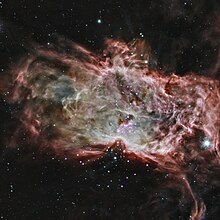NGC 2024
外观
| 发射星云 | |
|---|---|
 | |
| 观测资料: J2000.0 epoch | |
| 赤经 | 05h 41m 54s |
| 赤纬 | -01° 51′ 0.0″ |
| 距离 | 1350[1] 光年 (415 秒差距) |
| 视星等 (V) | 10[2] |
| 视尺度(V) | 30'x30' |
| 星座 | 猎户座 |
| 物理性质 | |
| 半径 | 6 ly |
| 名称 | NGC 2024和沙普利斯 277 |
火焰星云,给定的名称是NGC 2024和Sh2-277,是在猎户座的一个发射星云,距离地球大约在900-1,500光年。
猎户腰带最东边的参宿一(猎户座ζ),以高能的紫外光照射到旁边巨大的氢气云,将留驻在云气中的氢电离。当电子和电离氢重新结合时,会产生大量的辉光。位于星云明亮部分前面,额外的暗气体和尘埃是导致发光气体中心出现暗网络的原因。火焰星云,包括著名的马头星云,是猎户座分子云复合体的一部分,这是一个恒星形成区域。
火焰星云的中心是由新形成的恒星组成的星团[3],其中的成员86%都有星周盘[4]。钱德拉X射线天文台的 X射线观测[5][6]显示有数百颗的年轻恒星,估计数量已有800馀颗[7]。X射线和红外影像表明,最年轻的恒星集中在星团中心附近[8][9]。
图集
[编辑]-
来自拉西拉天文台,以 B、V和R滤镜三色合成的光学影像。
-
来自2MASS的红外影像。
-
来自VIST的近红外影像。
-
猎户腰带和火焰星云区域的可见光广视场图。
-
钱卓X射线天文台所见的NGC 2024。
-
火焰星云和马头星云。
-
以Hα所见的火焰星云和马头星云
参考资料
[编辑]- ^ Meyer, M. R.; et al. Star Formation in NGC 2023, NGC 2024, and Southern L1630. Reipurth, B. (编). Handbook of Star Forming Regions, Volume II: The Southern Sky ASP Monograph Publications 5. 2008: 43. Bibcode:2008hsf1.book..662M. ISBN 978-1-58381-670-7.
- ^ Is the Flame nebula easier to see than the Orion nebula?. stargazerslounge.com. [2018-03-24]. (原始内容存档于2023-03-03).
- ^ Haisch, K. E. Jr.; Lada, E. A.; Lada, C. J. A Near-Infrared L-Band Survey of the Young Embedded Cluster NGC 2024. Astronomical Journal. 2000, 120 (2): 1396–1409. Bibcode:2000AJ....120.1396H. S2CID 18143699. arXiv:astro-ph/0006219
 . doi:10.1086/301521.
. doi:10.1086/301521.
- ^ Haisch, K. E. Jr.; et al. A Mid-Infrared Study of the Young Stellar Population in the NGC 2024 Cluster. Astronomical Journal. 2001, 121 (3): 1512–1521. Bibcode:2001AJ....121.1512H. S2CID 1645511. arXiv:astro-ph/0012482
 . doi:10.1086/319397.
. doi:10.1086/319397.
- ^ Skinner, S.; Gagné, M.; Belzer, E. A Deep Chandra X-Ray Observation of the Embedded Young Cluster in NGC 2024. Astrophysical Journal. 2003, 598 (1): 375–391. Bibcode:2003ApJ...598..375S. S2CID 18798394. arXiv:astro-ph/0306566
 . doi:10.1086/378085.
. doi:10.1086/378085.
- ^ Broos, P. S.; et al. Identifying Young Stars in Massive Star-forming Regions for the MYStIX Project. Astrophysical Journal. 2013, 209 (2): 32. Bibcode:2013ApJS..209...32B. S2CID 67827240. arXiv:1309.4500
 . doi:10.1088/0067-0049/209/2/32.
. doi:10.1088/0067-0049/209/2/32.
- ^ Kuhn, M. A.; Getman, K. V.; Feigelson, E. D. The Spatial Structure of Young Stellar Clusters. II. Total Young Stellar Populations. Astrophysical Journal. 2015, 802 (1): 60. Bibcode:2015ApJ...802...60K. S2CID 119309858. arXiv:1501.05300
 . doi:10.1088/0004-637X/802/1/60.
. doi:10.1088/0004-637X/802/1/60.
- ^ Getman, K. V.; Feigelson, E. D.; Kuhn, M. A. Core-Halo Age Gradients and Star Formation in the Orion Nebula and NGC 2024 Young Stellar Clusters. Astrophysical Journal. 2014, 787 (2): 109. Bibcode:2014ApJ...787..109G. S2CID 118503957. arXiv:1403.2742
 . doi:10.1088/0004-637X/787/2/109.
. doi:10.1088/0004-637X/787/2/109.
- ^ Nemiroff, R.; Bonnell, J. (编). Inside the Flame Nebula. Astronomy Picture of the Day. NASA. 10 May 2014 [February 14, 2015].
外部链接
[编辑]- NGC 2024. SIMBAD. 斯特拉斯堡天文资料中心.
- Nemiroff, R.; Bonnell, J. (编). The Flame Nebula in Infrared. Astronomy Picture of the Day. NASA. 13 July 1999.
- WikiSky上关于The Flame Nebula的内容:DSS2, SDSS, GALEX, IRAS, 氢α, X射线, 天文照片, 天图, 文章和图片
| 天文学目录 | ||
|---|---|---|
| NGC天体表: | NGC 2022 - NGC 2023 - NGC 2024 - NGC 2025 - NGC 2026 | |







